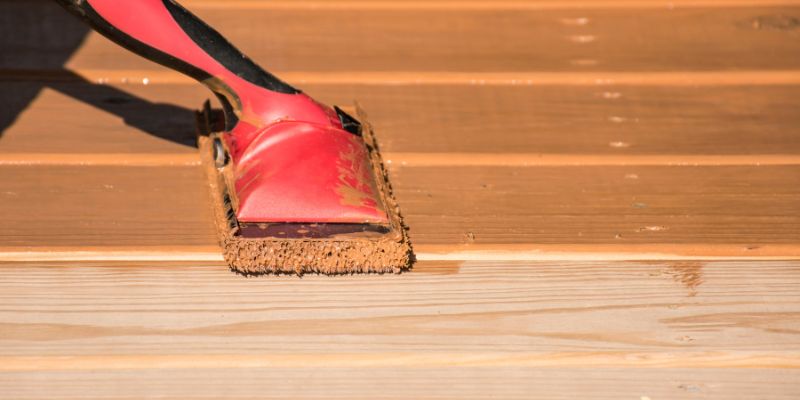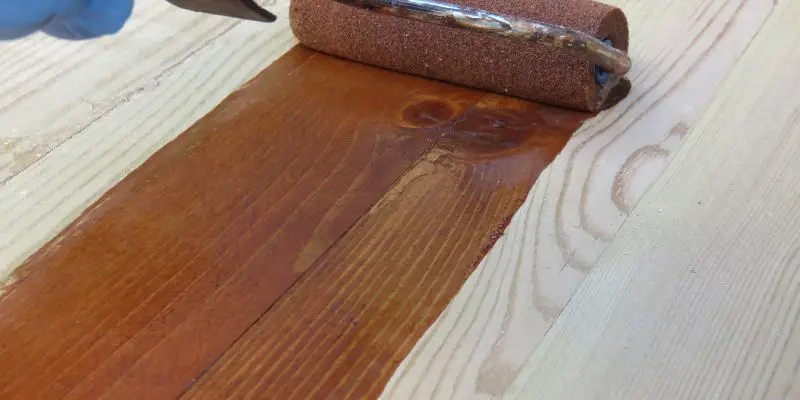Yes, concrete stain can be used on wood surfaces, providing a unique and durable finish. Concrete stains penetrate the wood’s pores to add color and create a weather-resistant barrier.
Preparing The Wood
Before applying concrete stain on wood, it’s essential to properly prepare the wood surface. This step is crucial to ensure that the stain adheres correctly and results in a beautiful and long-lasting finish. Three key factors that contribute to preparing the wood are choosing the right type of wood, cleaning and sanding the wood, and applying a wood conditioner.
Choosing The Right Type Of Wood
When it comes to using concrete stain on wood, selecting the appropriate type of wood is crucial. Not all woods are suitable for this process, as some may not absorb the stain properly or may react unfavorably. To achieve the best results, it is recommended to use hardwoods such as oak, maple, or cherry, as they have a dense cellular structure that allows for better stain absorption than softwoods like pine or spruce.

Cleaning And Sanding The Wood
Prior to staining, it is imperative to clean the wood surface thoroughly. Dirt, dust, or any other contaminants can negatively impact the stain’s ability to penetrate the wood evenly. Start by removing any loose debris with a broom or vacuum cleaner. Then, use a gentle wood cleaner or warm soapy water to remove any dirt or grime. Rinse off the cleaning solution with clean water and allow the wood to dry completely before proceeding.
Sanding the wood is the next vital step to achieve a smooth and uniform surface for staining. Use sandpaper with a medium grit, around 120 to 150, to remove any rough areas or existing finishes. Sand in the direction of the wood grain to avoid creating unsightly scratches. After sanding, remove the dust residue by wiping the wood with a tack cloth or a damp cloth.
Applying A Wood Conditioner
To ensure that the concrete stain is absorbed evenly and prevents blotchiness, applying a wood conditioner is highly recommended. Before doing so, ensure the wood is clean, dry, and free from any dust or debris. Wood conditioners are available in a liquid form and help prepare the wood by sealing the pores and equalizing the stain absorption. Apply the wood conditioner with a brush, roller, or cloth, following the manufacturer’s instructions. Allow the conditioner to penetrate the wood for the recommended time before proceeding with staining.
By preparing the wood surface properly through these steps, you can achieve excellent results when applying concrete stain. Choosing the right type of wood, cleaning, sanding, and using a wood conditioner will enhance the final outcome, creating a stunning finish that highlights the natural beauty of the wood while providing a durable and long-lasting surface.
Applying Concrete Stain On Wood
Concrete stain has long been a popular choice for bringing life and color to concrete surfaces, but did you know that you can also use it to transform wood? That’s right! Concrete stain can be a versatile and stunning option for enhancing the appearance of your wooden surfaces, whether it be decks, fences, or furniture. In this article, we will guide you through the process of applying concrete stain on wood, ensuring a beautiful and long-lasting finish.
Selecting The Right Concrete Stain For Wood
Before diving into the staining process, it is crucial to choose the right concrete stain for your wood project. Not all concrete stains are suitable for wood, as the composition and application requirements differ. When selecting a stain, make sure it is specifically labeled for use on wood surfaces. Pay attention to the stain’s color options as well, as it can greatly impact the final look of your wood. Consider the existing color scheme and the desired outcome to make an informed decision.
Testing The Stain On A Small Area
Before applying the stain to the entire wood surface, it is highly recommended to conduct a test on a small, inconspicuous area. This serves two purposes: allowing you to preview the effect of the stain on your wood and ensuring compatibility between the stain and the surface. Apply a small amount of the stain and let it dry completely. Assess the color, texture, and overall appearance to ensure it meets your expectations. If satisfied, proceed with confidence to stain the entire wood surface.
Applying The Stain With A Brush Or Roller
Now comes the fun part – applying the concrete stain! The method of application will depend on the size and nature of the wood surface. For smaller areas or intricate details, a brush can be the ideal tool for precision and control. On the other hand, a roller is suitable for larger areas, ensuring a smooth and consistent application. Remember to wear gloves and protective clothing throughout the process to avoid any contact with the stain.
Adding Multiple Coats For Desired Effect
In order to achieve the desired color intensity and depth, it may be necessary to apply multiple coats of concrete stain. Apply each coat evenly and allow sufficient drying time between each layer. You can build up the color gradually, assessing the results after each application. Keep in mind that the final appearance may vary depending on the type of wood and its absorption capabilities. Adjust the number of coats accordingly to achieve the perfect finish.
Sealing And Protecting The Stained Wood
Once you are satisfied with the stained wood surface, it is essential to seal and protect it to maximize durability and longevity. Apply a clear protective sealant over the stained surface, following the manufacturer’s instructions. This will not only enhance the appearance but also shield the wood from UV rays, moisture, and other potential damage. Regular maintenance, including cleaning and reapplication of the sealant as needed, will help preserve the beauty and integrity of the stained wood.
Tips And Tricks For Successful Projects
When it comes to staining wood, concrete stain might not be the first thing that comes to mind. However, concrete stain can actually be a great option for adding color and depth to wooden surfaces. Whether you’re looking to restore an old piece of furniture or give a new item a unique look, concrete stain on wood can produce beautiful and long-lasting results. In this article, we’ll explore some tips and tricks for successful projects using concrete stain on wood.
Mixing And Diluting Concrete Stain For Wood
Mixing and diluting the concrete stain properly is essential for achieving the desired effects on wood. Concrete stain is typically available in concentrated form, so it needs to be mixed with water or another solvent before application. Follow the manufacturer’s instructions for the appropriate dilution ratio, which can vary depending on the brand and type of stain.
It’s important to mix the stain thoroughly to ensure an even distribution of color. Use a stir stick or mechanical mixer to combine the stain and solvent in a separate container. Avoid applying the stain directly from the original container, as it may result in uneven coloration.
Creating Unique Effects With Different Application Techniques
Concrete stain on wood offers a wide range of application techniques that can create unique and artistic effects. Here are some techniques you can experiment with:
- Brushing: Use a brush to apply the stain, creating brush strokes for a textured look.
- Ragging: Dampen a rag or cloth with the stain and apply it in a wiping or dabbing motion to achieve a mottled or distressed effect.
- Spraying: Use a sprayer to evenly coat the wood surface with the stain, achieving a smooth and consistent finish.
Each technique can produce different results, so it’s worth trying out different methods to find the one that best suits your project.

Experimenting With Colors And Patterns
Concrete stain for wood comes in a variety of colors, allowing you to create unique and eye-catching patterns. You can either use a single color for a uniform look or experiment with multiple colors to create interesting designs. Consider using stencils or painter’s tape to create patterns or borders, adding another dimension to your stained wood project.
Before applying the stain, it’s advisable to do a test on a small, inconspicuous area of the wood to see how the color will appear. This allows you to adjust the stain or change the combination of colors if needed.
Properly Maintaining Stained Wood Surfaces
Maintaining the appearance and durability of stained wood surfaces is essential for their longevity. Here are some tips for proper maintenance:
- Regular cleaning: Dust and clean the stained wood regularly using a soft cloth or mop. Avoid using abrasive cleaners that could damage the stained surface.
- Protective coatings: Consider applying a clear topcoat or sealer to protect the stained wood from moisture, UV rays, and everyday wear and tear.
- Preventing damage: Use coasters or placemats to avoid direct contact between hot objects, liquids, or sharp objects and the stained wood surface.
With proper maintenance, your stained wood project will continue to impress for years to come.
Frequently Asked Questions On Can You Use Concrete Stain On Wood
How Do You Make Concrete Stain Look Like Wood?
To make concrete stain look like wood, follow these steps:
1. Clean and prep the concrete surface.
2. Apply a base coat of concrete stain in a color that resembles wood.
3. Use a wood grain tool or a sponge to create a wood grain texture.
4. Apply a second coat of stain in a darker shade to enhance the wood-like appearance.
5. Seal the stained concrete to protect the finish and provide durability.
Can Wood Stain Be Used On Concrete?
Yes, wood stain can be used on concrete surfaces. It provides an attractive and durable finish, enhancing the appearance of the concrete. Make sure to properly clean and prepare the concrete before applying the stain. Follow the manufacturer’s instructions for best results.
Remember to apply a clear sealer after staining to protect the surface.
What Is The Difference Between Concrete Stain And Paint?
Concrete stain penetrates the surface, enhancing its natural appearance, while paint coats the surface with a colored layer. Stain allows texture and imperfections to show through, whereas paint provides a solid and opaque finish. Stain is more durable and long-lasting, as it won’t peel or chip like paint.
Will Concrete Stain Stick To Paint?
Yes, concrete stain can stick to paint.
Conclusion
Using concrete stain on wood can be a creative and cost-effective way to enhance the appearance of your wooden surfaces. While it may require some extra care and preparation, the results can be stunning. Remember to choose the right type of stain for the task and follow the proper application techniques.
If done correctly, you can achieve a unique and beautiful finish that will surely impress. So, don’t hesitate to experiment with concrete stain on wood and unleash your creativity in home improvement projects.


